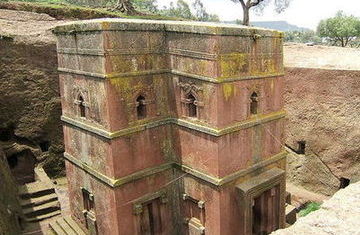
Above: “From the 16th to the middle of the 19th centuries,
virtually the whole of the Middle East was under the suzerainty
of the Ottoman Empire. When one of the Zagwe kings in Ethiopia,
King Lalibela (1190-1225), had trouble maintaining unhampered
contacts with the [Ethiopian] monks in Jerusalem, he decided to
build a new Jerusalem in his land. In the process he left behind one
of the true architectural wonders known as the Rock-hewn Churches
of Lalibela.” (From Tadias archives: History of Ethiopian Church
Presence in Jerusalem).
AFP
By Emmanuel Goujon –
LALIBELA, Ethiopia (AFP) — The ancient mystery shrouding Lalibela, Ethiopia’s revered medieval rock-hewn churches, could be lifted by a group of French researchers given the go-ahead for the first comprehensive study of this world heritage site legend says was “built by angels”. The team will have full access to the network of 10 Orthodox chapels chiseled out of volcanic rock — some standing 15 metres (42 feet) high — in the mountainous heart of Ethiopia. Read more.


























It will be interesting to see what the conclusions are. I believe King Lalibela himself was the architect. He conceptualized, designed and build the churches. “Lalibela is said to have seen Jerusalem in a vision and then attempted to build a new Jerusalem as his capital in response to the capture of old Jerusalem by Muslims in 1187.”(Wiki). There is nothing like these breathtakingly beautiful monolithic churches anywhere in the world. He might have employed outside contractors, archtects and stonemasons for various aspect of the building process, but Lalibela was the king with the vision and most likely personally supervised the construction of these monuments. Unfortunately, documents that may shade light about the construction process of these amazing 11 churches have been lost from history. Gebre Mesqel Lalibela, who is considered a saint by the Ethiopian church, was negus or king of Ethiopia from 1189 to 1229. Prior to being crowned king, he lived in political exile residing in Jerusalem for several years (right in the middles of the crusades). Wiki says “The Crusades were a series of religion-driven military campaigns waged by much of Latin Christian Europe. The specific crusades to regain control of the Holy Land (Jerusalem) were fought over a period of nearly 200 years, between 1095 and 1291.” So there is a strong possibility that during his long exile in Jerusalem, Lalibela might have befriended or hired Christian Europeans that later traveled back to Ethiopia with him and assisted in the construction, perhaps with modern tools, etc. Nonetheless, there is no dispute as to who either built or commissioned the churches. There is a new Amharic documentary about Lalibela (with English subtitles). I could not locate the link at the moment, but I will post when I find it.
Bless
Dear Yoni, you said: “He might have employed outside contractors, archtects and stonemasons for various aspect of the building process…” and I’ve to be honest, I don’t expect from an Ethiopian such a thought! We don’t need that, our fathers don’t deserve it, Sad indeed!
Dear Daniel,
Yes, I said: “He might have employed outside contractors, architects and stonemasons for various aspect of the building process…”
And you said: “I’ve to be honest, I don’t expect from an Ethiopian such a thought! We don’t need that, our fathers don’t deserve it, Sad indeed!”.
Dani, Please don’t be sad. That’s just one possible scenario for the researchers to look at. What is the other possible scenario or the truth? I am hungry for the knowledge. You have to educate me about my history so I don’t embarrass you or make you sad again.
Cheers,
Yoni
Yoni,
Lalibela was born in Roha in the second half of the twelfth century, the youngest son of the royal line of the Zagwe dynasty, which then ruled over much of northern Ethiopia. After the decline of the Axumite empire, Ethiopian leaders run into the mountains to protect each other from each other. “Inevitably, a fortress mentality took root: an intense suspicion of the motives of strangers, a hatred of intrusion and interference, a protective secrecy.” Does this sound familiar
During this exact period Ethiopians were amusedly described by the British historian Edward Gibbon as having slept for near a thousand years, forgetful of the world by whom they were forgotten. It was then that Lalibela had a vision and God told him how to design the churches, where to build them and how to decorate them. The legend continues, “Once he was crowned, he gathered masons, carpenters, tools, set down a scale of wages and purchased the land needed for the building. The churches are said to have been built with great speed because angels continued the work at night.”
If we set the legend aside for a moment and focus on the human and political realities that existed at the time: “The town of Lalibela was originally known as Roha. It was renamed after the 12th-century King Lalibela, who commissioned these extraordinary churches. Lalibela was a member of the Zagwe dynasty, which had seized the Ethiopian throne around 1000 AD. When his rivals began to increase in power, Lalibela sought the support of the powerful Ethiopian Orthodox Church by building the churches in this small town.”
So Lalibela’s motivation was partly political and partly defensive, but left behind an amazing creation!
Please can you write in Amharic. It will be more helpful.